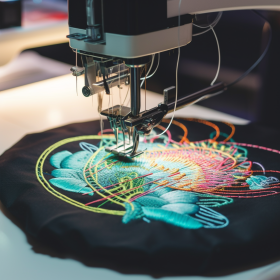In the modern embroidery industry, creativity meets technology through a process called digitization for embroidery. Whether you’re a small embroidery business or a global apparel brand, your design’s quality depends heavily on how well it’s digitized. In simple terms, embroidery digitizing converts artwork into a stitch file that an embroidery machine can read and execute precisely. This process bridges the gap between imagination and fabric, ensuring every thread tells a story of perfection.
In this blog, we’ll explore what digitization for embroidery really means, how it works, why it’s so important, and how professional Embroidery Digitizing services can elevate your brand’s identity.
What is Digitization for Embroidery?
Digitization for embroidery is the process of transforming a graphic design—like a logo, artwork, or illustration—into a digital embroidery file. This file contains a set of commands that instruct an embroidery machine where, when, and how to place each stitch.
Unlike printing or screen printing, embroidery requires an exact understanding of how threads, needles, and fabric types behave. That’s where digitizing software and skilled digitizers come in. They use specialized programs like Wilcom, Hatch, or Pulse to create files compatible with embroidery machines (such as .DST, .PES, .EXP, or .JEF formats).
The goal is to make sure the embroidery looks exactly like the original design—but with the added texture, shine, and depth that only stitching can provide.
The Step-by-Step Process of Embroidery Digitizing
Digitizing isn’t just clicking “convert.” It’s a careful process requiring precision, technical skill, and artistic judgment. Let’s break it down step-by-step:
1. Preparing the Artwork
The digitizer starts with the original artwork (logo, design, or sketch). They clean and simplify it, removing unnecessary details that might not translate well into stitches.
2. Selecting Stitch Types
Different areas of the design require different stitch types:
-
Satin stitches for borders and letters
-
Fill stitches for large filled areas
-
Running stitches for fine lines and details
The digitizer decides which stitch type best suits each part of the design.
3. Choosing the Right Pathing
Pathing refers to the order in which the machine embroiders different parts of the design. Efficient pathing avoids unnecessary jumps and trims, making the design look cleaner and run faster.
4. Setting the Density and Underlay
Density controls how closely stitches are placed together. Too dense, and the fabric may pucker. Too light, and the design may look incomplete.
Underlay stitches act as a foundation, giving structure and stability to the top stitches—especially on stretchy or textured fabrics.
5. Adjusting for Fabric Type
Not all fabrics behave the same way. Digitizers must tweak settings based on whether the fabric is cotton, leather, polyester, or denim. For example, stretchy fabrics need looser stitch density, while thick materials require stronger underlays.
6. Final Testing
Once the file is complete, it’s tested on a machine to ensure accuracy. Any flaws—like thread breaks, misalignment, or gaps—are corrected before the final file is delivered.
Why Digitization for Embroidery Matters
You might wonder, why not just let the machine do it automatically? The truth is, Embroidery Digitizing is an art form that requires human expertise.
A poorly digitized file can lead to:
-
Thread breaks during stitching
-
Uneven lettering
-
Distorted logos
-
Wasted materials and production time
On the other hand, professional digitization for embroidery ensures:
-
Smooth machine runs
-
Crisp, detailed designs
-
Consistent results across different garments and fabrics
It’s not just about getting the job done—it’s about getting it done beautifully.
Benefits of Professional Embroidery Digitizing Services
If you run an embroidery business, outsourcing your digitization work to experts can save you both time and money. Here’s why:
1. Accuracy and Quality
Professional digitizers understand how to interpret your artwork and translate it into flawless stitch patterns. This precision ensures that every logo, patch, or monogram looks sharp and professional.
2. Time Efficiency
Manual digitizing can take hours, especially for complex designs. Experts streamline the process, delivering ready-to-use files quickly so you can focus on production.
3. Customization
Every fabric, thread type, and design requires custom attention. Professional Embroidery Digitizing services offer adjustments to meet specific needs, such as metallic threads, 3D puff effects, or gradient shading.
4. Cost Savings
While it may seem cheaper to digitize designs in-house, investing in professional services often saves money in the long run by reducing thread waste, machine downtime, and rework.
5. Scalability
Whether you need 1 design or 100, professional services can handle large orders with consistent quality and turnaround time.
Common Mistakes in Embroidery Digitizing (and How to Avoid Them)
Even experienced embroiderers can run into digitizing challenges. Here are a few common pitfalls to watch out for:
-
Too many stitches – leads to puckering and stiffness.
-
Tiny text or details – may not show up clearly when stitched.
-
Ignoring fabric type – results in distortion or poor texture.
-
Improper pathing – causes thread jumps and inefficient machine movement.
The solution? Always test your design before mass production and partner with a trusted digitization for embroidery service that prioritizes precision.
How Digitization for Embroidery Empowers Your Brand
Embroidery isn’t just decoration—it’s identity. From corporate uniforms to sports jerseys and fashion collections, a well-digitized embroidery design enhances your brand’s visual impact.
For businesses, Embroidery Digitizing helps maintain brand consistency across products—ensuring that your logo looks the same whether it’s stitched on a cap, polo shirt, or jacket.
Moreover, embroidery adds a tactile, premium feel that printing simply can’t match. It speaks of craftsmanship, attention to detail, and long-lasting quality—qualities every brand wants to be associated with.
Future Trends in Embroidery Digitizing
As technology continues to evolve, digitization for embroidery is also becoming smarter and more efficient. AI-assisted digitizing software is emerging, capable of suggesting stitch patterns and reducing manual adjustments. Cloud-based collaboration tools allow designers and digitizers to work together in real time.
At the same time, creative trends like 3D puff embroidery, gradient thread blending, and mixed-material stitching are pushing the boundaries of what’s possible. The future is digital—but the art remains human.
Conclusion
In the world of embroidery, digitization for embroidery is the silent engine that drives quality, precision, and creativity. It transforms digital art into stitched reality—making sure every line, curve, and color tells your brand’s story perfectly.
Whether you’re an apparel brand, promotional company, or hobbyist, investing in professional Embroidery Digitizing ensures your designs look their best—every time. Because when technology and artistry work hand in hand, the results are nothing short of embroidered perfection.





